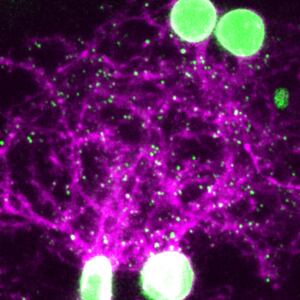If being shuttered away for the last two years has got you feeling like you’re operating on your last two brain cells, that might not be a stretch—at least as far as your memory goes. In a new study published on Monday in Nature Neuroscience, scientists at Cedars-Sinai Medical Center in Los Angeles and other research institutions have discovered that two cells in the human brain mastermind our ability to store and retrieve information—a breakthrough that not only helps shed light on the murky processes that govern memory but could also open the door to creating more effective strategies to combat memory disorders associated with aging and diseases like Alzheimer’s and dementia.
Since the first memory experiments run by German psychologist Hermann Ebbinghaus in the 19th century, scientists have learned a ton about what parts of the brain (like the hippocampus) are involved in memory, and how our minds seem to store information into discrete events, or episodes. But one nagging question has always remained: How and what determines the start and end of a memory?
“Our brain is [constantly] getting a continuous stream of sensory information,” Stephen Maren, a behavioral neuroscientist at Texas A&M University, who was not involved in the study, told The Daily Beast. “How we lump it into these experiences, how those boundaries are created, and how we form events in memory really isn’t known.”
ADVERTISEMENT
It turns out the answer hinges on two types of neurons that react to changes in the who, what, where, and when of an experience as it unfolds for an individual—information that neuroscientists call “cognitive boundaries.”
As part of their new investigation, the Cedars Sinai team examined the brain activity of 19 patients diagnosed with drug-resistant epilepsy as they watched film clips. The researchers found that certain neurons fired up in response to certain cognitive boundaries. For example, when a “soft” boundary was introduced into a clip—like if two people talking and walking down a hallway are then joined by a third person in the next scene—a group of neurons the researchers named “boundary cells” lit up. When the narrative of a scene completely changed—like if the second scene involved different people driving in a car—this constituted a “hard” boundary. Boundary cells still lit up, but so too did another group of neurons called “event” cells.
Ueli Rutishauser, a neuroscientist at Cedars-Sinai and a co-author of the new study, told The Daily Beast that he likens the process to creating and storing files in folders on your computer. Experiencing a new boundary cues your brain into closing the first “memory” folder and creating a new one. When shown still images from a video clip, the study’s participants were more likely to remember images that closely followed a hard or soft boundary; but they had greater difficulty remembering the correct order of these images on opposite sides of a hard boundary. According to Rutishauser, this is probably because the brain has to recall memories that have been stored separately.

The researchers also noticed that if an event or boundary cell fired at the same time as the brain’s theta rhythm—an electrical frequency that coordinates information between different brain areas—patients were also more likely to remember the order of the images shown to them.
“We found that boundary cells care about theta waves and they fire at a specific phase of theta. And if they don’t, then the order of memories is not created,” Rutishauser said.
The new findings are especially of interest given that the U.S. is expecting the number of Americans living with Alzheimer’s disease to increase to 7.1 million by 2025, according to a 2020 report from The Alzheimer’s Association. Another 2021 report projects worldwide cases of dementia to triple by 2050.
While Rutishauser cautioned there is no immediate use for his group’s findings in clinically treating Alzheimer’s or dementia head-on, he believes unraveling the mystery of human memory may guide more effective memory loss treatments and techniques down the road.
“I think [the findings] provide some important new knowledge that could be used for developing new treatments, which could either be behavioral [and] indicates one could perhaps structure experience in a way that there are more boundaries,” he said. For example, in a home with people suffering from memory loss, individuals could try sitting in different areas of their home or going outside to break up the monotony of their surroundings.
Maren added that he would be “curious to know whether an emotional experience, even if it were a feeling, could itself form a boundary. Like if you have a sense of fear that suddenly emerges, does that sort of mark an event in your episodic experience?” While the information might not yet present help in treating disorders caused by traumatic memories, Maren said it would prove to be “an issue worthy of future study for the implications it might have understanding the content of traumatic memory."
As for the next steps, Rutishauser and his team are interested to see whether activated event and boundary cells coax other neurons to secrete dopamine, a neurotransmitter linked with memory and learning. Ultimately, they want to see their research potentially enhance emerging treatments for memory disorders like deep brain stimulation.
“It really remains to be seen how we can understand these mechanisms at play in a fully natural environment like in a social situation where we talk to each other,” said Rutishauser. “But it’s a major step in the right direction.”






